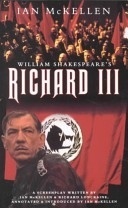Ian McKellan played Richard III on the stage in London, then touring the world, under Richard Eyre’s direction and the Royal National Theatre of Great Britain’s auspices. Like many great productions of Richard III in the past, there was an anticlimactic sense about things when the lengthy run ended – McKellan compares his production (justifiably) to those of Henry Irving and David Garrick, but longs for the lasting legacy of Laurence Olivier, who translated his successful stage production into a lasting cinematic production. Richard Eyre issued the challenge to McKellan to produce a screenplay, which he did, in collaboration with Richard Loncraine. It is true that Shakespeare is the ‘author’ of Richard III – of course, much of Shakespeare’s authoring involved heavy borrowing, redaction and crafting. This is not to take anything away from Shakespeare’s achievement, but rather to prove the adage ‘good writers borrow from others; great writers steal from them outright’. However, every production of a Shakespeare play requires modification of some sort; bringing Shakespeare productions to the screen (indeed, bringing any stage-play to the screen) requires a recrafting to suit the medium. McKellan and Loncraine rearranged and edited expertly the play to suit a film. McKellan provides a brief introduction to the history and the play. Richard III has been an enigmatic and controversial character – Shakespeare’s play is probably more in keeping with Tudor propaganda against Richard III (from whom they took the throne) rather than actual history; Richard’s malformed physical form and malicious character may be fictions, or at least great exaggerations, designed to serve the purpose of bolstering Tudor legitimacy. McKellan points out (a theory not unique to him, by any means) that the Tudors had as much to gain from the disappearance of the princes in the tower as Richard himself; had they survived and been recognised as heirs of the throne, Tudor legitimacy would have been much less credible. McKellan describes the decision to update the tale of Richard III into more modern times as one to provide clarity of narrative. Indeed, for this production, Richard is seen as a storm-trooper similar to the militant cadres of Germany in the 1930; his grasp for power is very similar in tone to the rise to dictatorship of any number of fascist leaders, but the Nuremberg-Rally character of Richard’s accession leaves little doubt as to the parallel. On stage and screen, in a drama such as these, people need to be readily identified in their roles; Elizabethan dress (or earlier dress) is confusing to the modern eye, but the difference between costuming for military, aristocracy, etc. in the modern time is readily identifiable. The exact historical situation is not directly relevant – given that Richard III already takes liberties with the actual history of the time, why not take more in the name of accessibility to the audience? McKellan gives an extensive background tale to the problems of revision (Richard III had to be cut; be turned into a visual rather than auditory experience, given the sensibilities of modern cinema-goers; etc.) and the tale of finding support, backing and funding. He talks about the difficulties involved in finding adequate sets and actors (McKellan originally envisioned filming around the British Parliament; due to various issues, that idea was squashed, but the alternative, the Parliament in Budapest, became a fascinating and acceptable alternative, particularly given that the building is Budapest was modeled after the one in Westminster). With final funding, casting, director and all in place, the show did proceed. This is not the complete text of Richard III by any means. As McKellan points out, Shakespeare plays have been trimmed since the very beginning, to suit times, troupes and audiences. Richard III is one of the longer plays – few audiences would be willing to sit through three to four hours of Shakespeare in the cinema, particularly for a lesser-known play. Thus, this is a version roughly two-thirds the actual length; however, due to cinematic magic, most of the story remains without great distortion. There is a running commentary throughout the screenplay. This includes both commentary on the play and commentary on the film. Production photos complement the text, including some scenes that were not included in the final film. The screenplay not only includes the text of the dialogue, but also other production directions and descriptions, particularly of those relatively few scenes in which there is no dialogue. This is a fascinating look at the back-side of a Shakespeare play-become-film. I highly recommend it to fans of Shakespeare, McKellan, modern culture, and those with a care for the cross-currents of the various strands in primary Western culture. 010115R
WILLIAM SHAKESPEARE’S RICHARD III (Screenplay)
$14.00
Sold Out
Additional Information
| Author | Ian McKellen, Richard Loncraine |
|---|---|
| Number of pages | 299 |
| Publisher | Overlook Press |
| Year Published | 1996 |
| Binding Type | Softcover |
|---|
